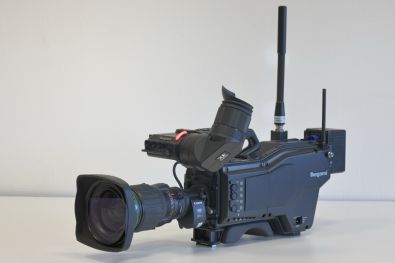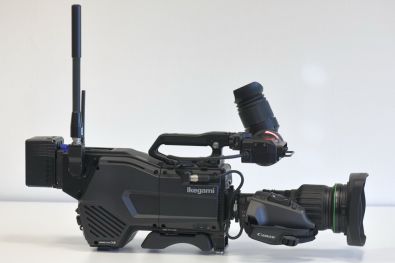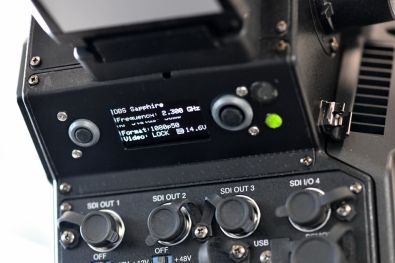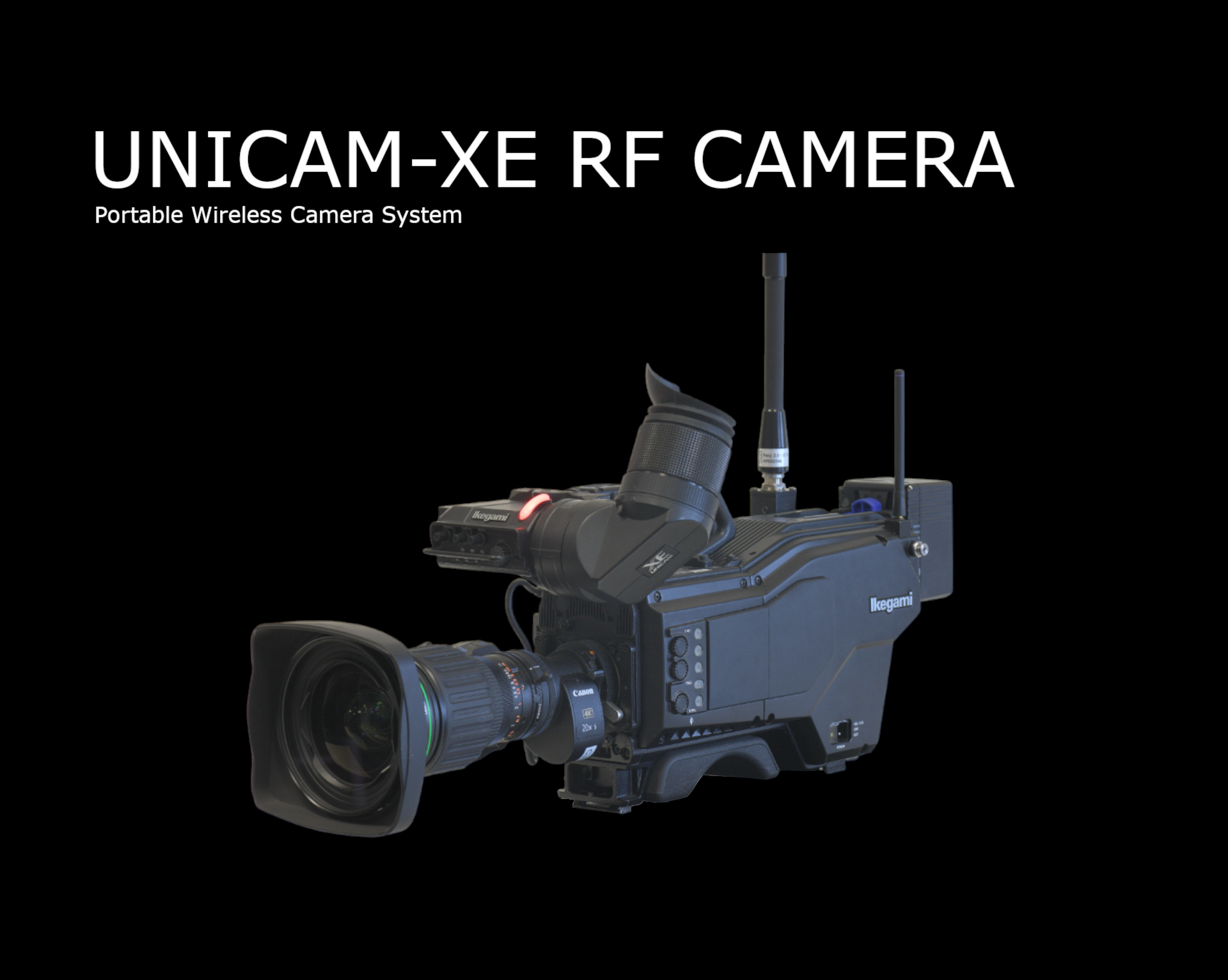
UHK-X700RF - 4K/HD WIRELESS PORTABLE CAMERA SYSTEM
In a modern live production environment - be it in studio or outdoor applications - wireless camera systems play an increasingly important role. New transmission technologies, improved codecs and miniaturization of electronic circuits enabled the engineers of broadcast equipment to manufacture wireless transmission systems with highest performance, low latency and outstanding signal robustness. Due to a clever integration into the existing Ikegami UNICAM-XE portable camera bodies, the Ikegami wireless camera solution remains compact and lightweight and gives the same operational feeling to the camera operator as if a conventional camera with fiber cable would be used. However, the wireless technology liberates the camera operator from cable restrictions and will allow him to freely move around shooting new and creative perspectives.
The Concept of the Ikegami Wireless Camera System
The Ikegami wireless camera system was designed to be perfectly integrated into the UNICAM-XE portable camera models (UHK-X700/-X600 and HDK-X500). Instead of the conventional fiber transmission section, a very similar looking wireless section will be integrated. As such, weight, weight balance and size of the portable camera is not changed. The visible differences to the fiber version of both camera types are just the two antennas on the back (one for the main video signal, the smaller one for the telemetry data) and the battery to power the camera.
Key Features at a Glance
- The transmitter section that is fully integrated into the UHK-X700/-X600 or HDK-X500 camera body features a true 4K HEVC encoder (H.264 and H.265) with a COFDM modulator.
- Separate transmitters for Camera Remote and Tally signals are also integrated into the same unit.
- The same size, weight and weight balance compared to the fiber cable version (i.e.: 5.1 kg for the UHK-X700RF body).
- Transmitter settings are accessible through a single-color panel on the rear side of the camera.
- HD and UHD formats are supported both in SDR and HDR (High Dynamic Range)

- Low latency in UHD/HD resolution encoding (40ms input to output).
- DVB-T Bandwidth: Dual Ped, 8-/7-/6- and 5-MHz modes.
- DVB-T Guard Intervall: 1/32; 1/16; 1/8; 1/4.
- DVB-T FEC (Forward Error Correction): 1/2; 2/3; 3/4; 5/6; 7/8.
- DVB-T Modulation selectable: QPSK, 16QAM, 64QAM.
- 2 audio inputs (on camera) embedded into the video stream.
- Tally Interface.
- Camera Control is available by using common Ikegami operation control panels: OCP-300, OCP-500 or MCP-300.
- V-Mount battery attachment.
- Multi-channel antenna diversity is a standard feature of the Ikegami wireless system.
- Modular receiver system to allow flexible antenna configurations to optimize the signal receipt.
System Components & Configurations
The core wireless system consists of two separate transmission systems, the main video link for the HD/UHD camera signal plus the SHF-link for remote control (camera racking). Intercom and Tally.
System Components (Camera Side)
The Ikegami UNICAM-XE RF camera is configured by using a conventional UNICAM-XE camera body (UHK-X700/ -X600 or HDK-X500) plus the transmitter section (BTX-198720). The BTX-198720 will be fully integrated into the camera body by Ikegami Electronics (Europe). Adding the VFL201D (2”-color LCD monocular viewfinder) and the omnidirectional antenna (Type: ATN3NF-200270) will complete the portable camera unit.
Only the desired B4-lens and a battery (with V-Mount) need to be added to obtain a fully working RF camera.
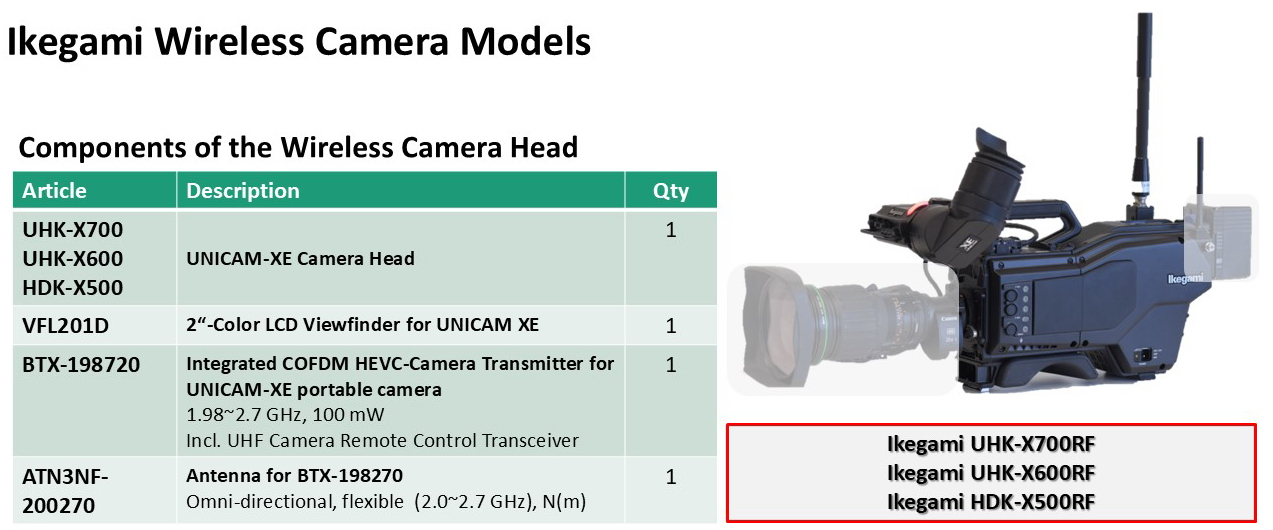
On the camera side, both links (i.e. for the main video signal plus the bi-directional signal for camera remote and Tally) are combined in one unit that is an integral part of the camera body (Type: BTX-198720). As such, we can see two antennas on the back side of the camera, each of them designed to meet the specific characteristics of the transmission technology employed.
On the receiving side, we have two separate units, one transceiver for the camera remote control including Tally and one receiver unit for the main video and audio signals including the decoding part.
System Components - Receiver and Decoder Unit (Sapphire-RXD5)
The Receiver and Decoder Unit for the main video and audio signals is manufactured by DOMO in the UK (Type: Sapphire-RXD5) and comes delivered in a full 19”-rack wide chassis (1 RU high), designed to be mounted in a conventional 19” rack.

It employs DVB-T modulation in QPSK, 16QAM and 64QAM mode. The bandwidth is switchable between 8 MHz, 7 MHz, 6 MHz and 5 MHz mode. To ensure a very robust signal quality, even under critical circumstances, the DVB-T Guard Interval can be switched in 4 discrete steps: 1/32, 1/16, 1/8, 1/4. The forward error correction (FEC) is also flexibly selectable from 1/2, 3/4, 5/6, 7/8 and 2/3 as a default value.
Sapphire-RXD5 employs H.265-HEVC and H.264-AVC video coding (switchable via menu) and supports almost all conventional broadcast frame rates for HD and UHD, both in SDR (standard dynamic range, ITU-R BT.709) as well as in HDR (high dynamic range, ITU-R BT.2100 and -BT2020 for wide color gamut).
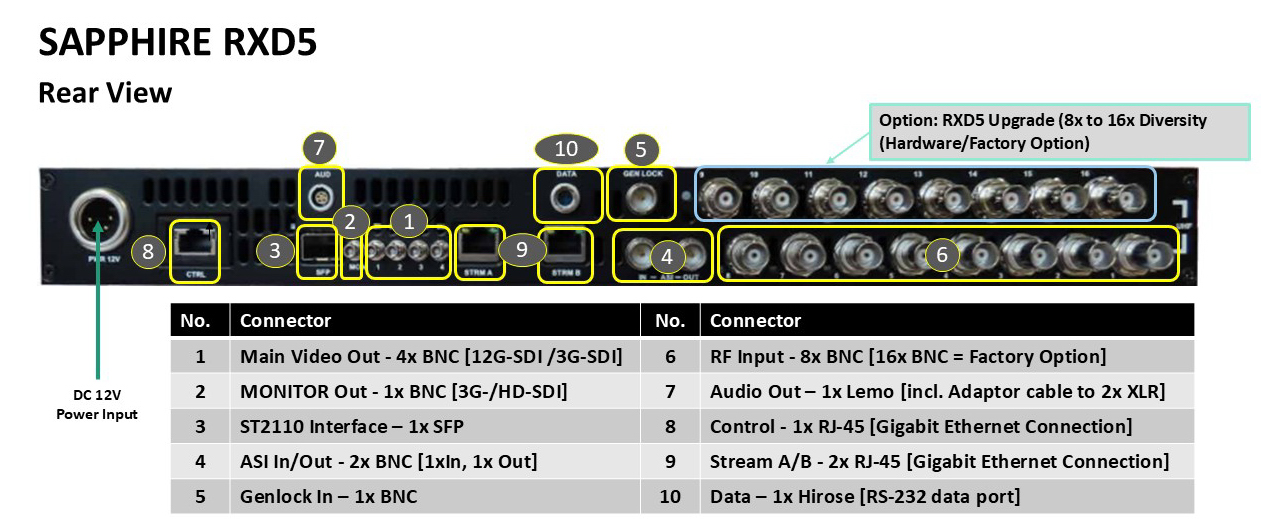
The receiver unit comes equipped with 4x BNC outputs and supports 1.5G, 3G and 12G SDI formats including embedded audio. An additional MONITOR output is available, supporting 3G and HDSDI formats. It also features 2 analogue audio outputs (2x XLR-3-pin), a genlock input (BNC) and a 4-pin XLR connector for 12V DC power input. The SFP-Interface provides an ST2110-Stream to integrate the Receiver into a wider ST2110 network.
In a "Standard Standard Configuration", the Sapphire RXD-5 (Type: RXD5-2) can connect directly to up to 2 downconverters by conventional BNC cables (up to 350m cable extension). By adding SW license options, the receiver can be upgraded to 4x, 6x and 8x diversity. By adding a hardware option, up to 16x antenna diversity is made possible.
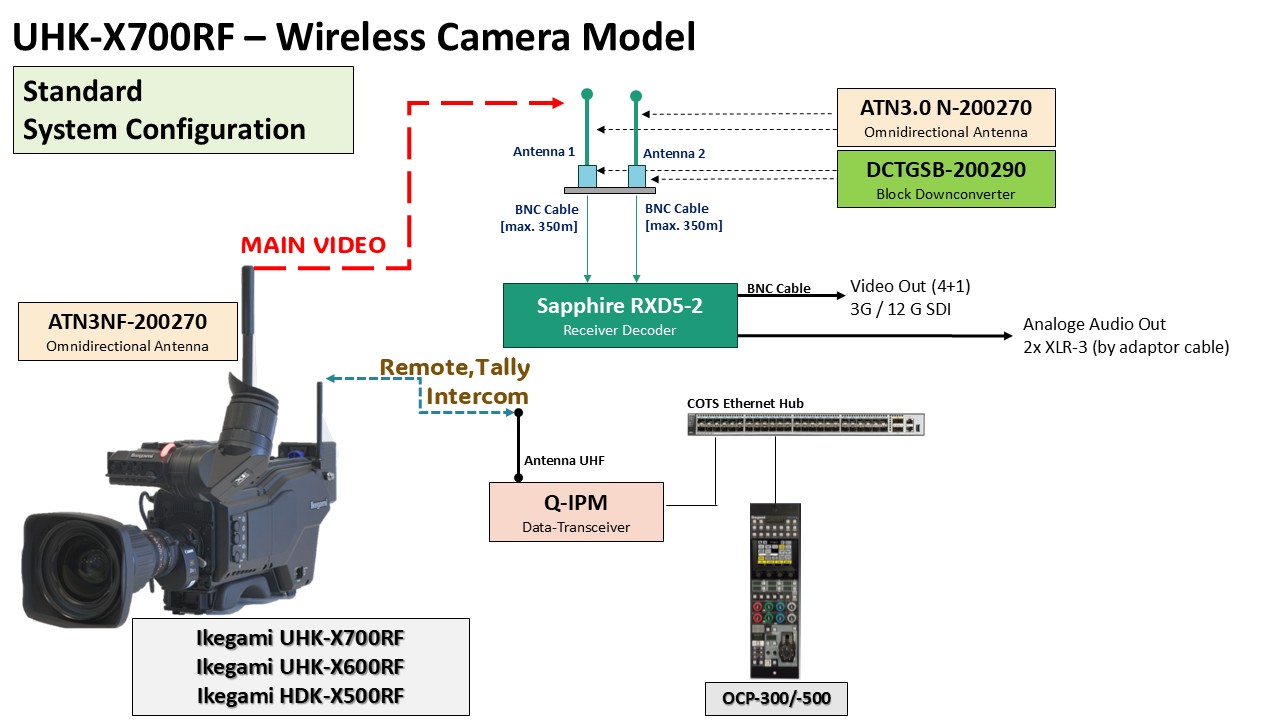
In case longer distances between receiving antennas and Sapphire-RXD5 are to be covered, it is possible to employ a fiber based outdoor unit (Type: ODU-G) in combination with a fully integrated Remote CCU (Type: IRFCCU) instead of SAPPHIRE RXD5. In this "Enhanced System Configuration", the antennas can directly be connected to the ODU-G that is connected to the IRFCCU via a conventional SMPTE fiber hybrid cable. In case the ODU-G will be powered through this fiber hybrid cable, the max. extension is limited to 1000m. If the ODU-G will be powered locally, up to 4000m cable extension is possible.

The "Enhanced System Configuration" provides a very flexible and remote position of the antennas by a common broadcast cable (i.e. SMPTE fiber hybrid cable) and - at the same time - an outstanding robustness of the transmitted signal via fiber since interferences by external sources can completely be ruled out.
Camera Remote Control, Intercom and Tally Signals
Tally, Intercom and remote control signals for the camera (bi-directional signal) are transmitted via a separate IP-Mesh data transceiver (Type: Q-IPM). To cover long distances, it is possible to employ IP-Mesh Repeaters (optional).

You want further information?
Feel free to contact us.
Service-Hotline: +49 (0) 2131 1230
E-Mail: broadcast@ikegami.de
Contact Form


2/3" 3 CMOS 4K GLOBAL SHUTTER SENSOR

A 3-CMOS optical system using newly developed 2/3-inch CMOS sensors boasts an S/N of 62dB and a sensitivity of F11 in 4KP50.
The high dynamic range of the sensors produces high-quality images with excellent colour reproduction. The CMOS sensors incorporate a global shutter pixel architecture, enabling the camera to capture natural images even under challenging situations. Fast moving objects are free from geometric distortion and there are no flash bands when the camera is shooting strobe lights or flashes from still cameras.
NO COLOUR ALIASING
Three-chip optical technology drastically reduces colour aliasing which is always an issue with single-chip cameras.
With the additional optional Low-Pass-Filter (OLPF-XE) aliasing effects can be reduced even more effectively which is especially helpful when shooting LED walls.
OPTICAL VIGNETTING CORRECTION (OVC)
Automatic electronic compensation of F-drop and vignetting.
* with supported lenses

DIRECT 4K OUTPUT
With a newly integrated video process the UHK-X700RF can output 4K video directly from the camera head via 12G-SDI (switchable to 3G-SDI for HD output).
REMOTE BACKFOCUS ADJUSTMENT (RBF)
The Remote Backfocus Adjustment function helps setting accurate backfocus even when the camera
head is located in an environment where it is hard to reach the back focus adjustment on the lens or
difficult to critically see the viewfinder picture.
*with supported lenses
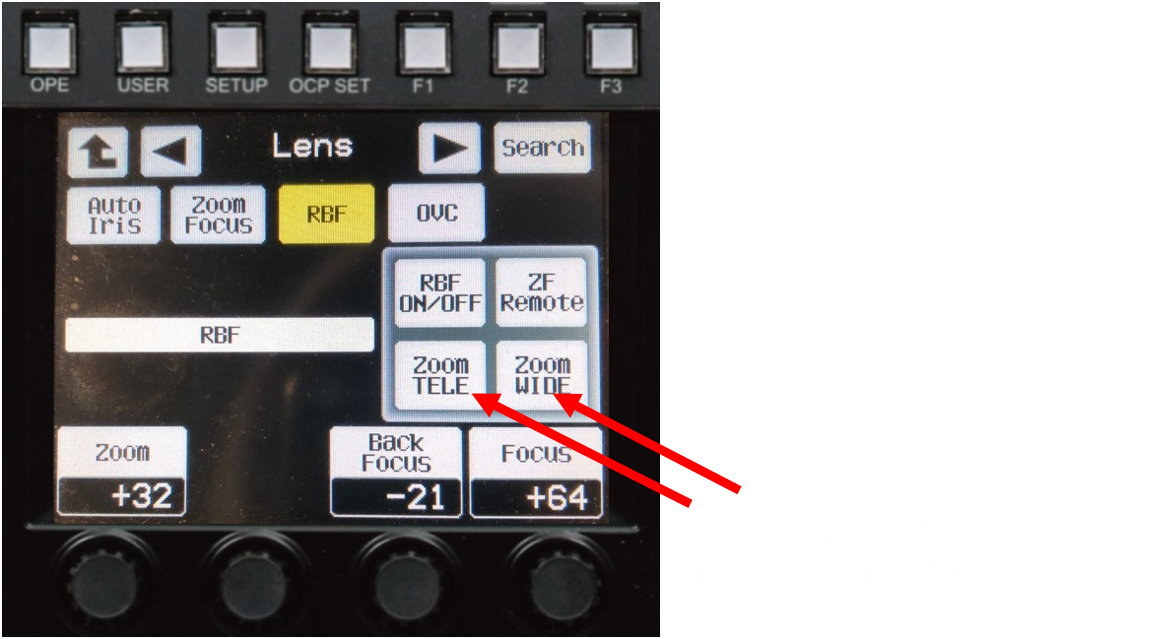
16-AXIS COLOUR CORRECTOR
Ikegami’s new ASIC AXII delivers full functionality including 16-axis colour correction and focus-assist for 4K and HD video modes. View more details.


FOCUS ASSIST FUNCTION
Finding the correct focus can be especially difficult while working with 4K cameras.
Ikegami's Quick EZ Focus Assist function is a newly incorporated useful tool, providing very distinct enhancements to the viewfinder signal, enabling the camera operator to make critical focus adjustments. The contour extracted from the 4K image is displayed in the viewfinder to assist precise focusing. The area size, area color, edge color, and display time on the viewfinder are adjustable in the camera menu.
WIDE COLOUR SPACE AND HDR
The UHK-X700RF provides an HLG (Hybrid Log Gamma) mode conforming to ITU-R BT.2100 which is an international standard for HDR. It is now possible to expand the range represented from dark to bright, providing superb bright pictures with High Dynamic Range. HLG and various other kinds of gamma curves can be flexibly set by users.
BT.2020 wide colour space and BT. 709 colour space are supported in 4K and HD modes.

COMPACT, LIGHTWEIGHT AND USER FRIENDLY
The compact body of the UHK-X700RF and its low weight of 5.1 kg combined with the low center of gravity create the perfect balance together with the adjustable shoulder pad while shooting on the shoulder. Additionally, the viewfinder can be adjusted in three axis.
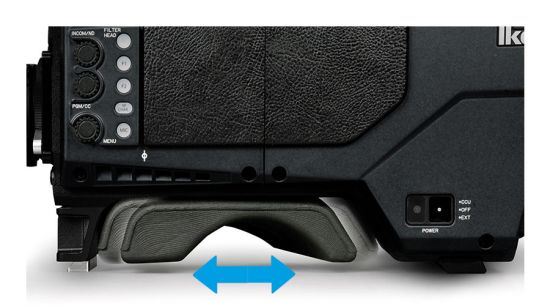
VIEWFINDERS
Two viewfinder models are available for the UHK-X700RF. The digital interface allows access to the camera menu from the viewfinder (for shoulder operation: VFL201D, for tripod/studio applications: VFL-P700AD, VFE-P711AD).




